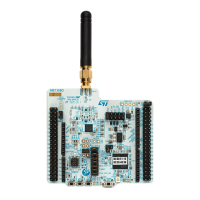RM0453 Rev 5 1063/1450
RM0453 Inter-integrated circuit (I2C) interface
1113
Slave transmitter
A transmit interrupt status (TXIS) is generated when the I2C_TXDR register becomes
empty. An interrupt is generated if the TXIE bit is set in the I2C_CR1 register.
The TXIS bit is cleared when the I2C_TXDR register is written with the next data byte to be
transmitted.
When a NACK is received, the NACKF bit is set in the I2C_ISR register and an interrupt is
generated if the NACKIE bit is set in the I2C_CR1 register. The slave automatically releases
the SCL and SDA lines in order to let the master perform a STOP or a RESTART condition.
The TXIS bit is not set when a NACK is received.
When a STOP is received and the STOPIE bit is set in the I2C_CR1 register, the STOPF
flag is set in the I2C_ISR register and an interrupt is generated. In most applications, the
SBC bit is usually programmed to ‘0’. In this case, If TXE = 0 when the slave address is
received (ADDR = 1), the user can choose either to send the content of the I2C_TXDR
register as the first data byte, or to flush the I2C_TXDR register by setting the TXE bit in
order to program a new data byte.
In Slave byte control mode (SBC = 1), the number of bytes to be transmitted must be
programmed in NBYTES in the address match interrupt subroutine (ADDR = 1). In this
case, the number of TXIS events during the transfer corresponds to the value programmed
in NBYTES.
Caution: When NOSTRETCH = 1, the SCL clock is not stretched while the ADDR flag is set, so the
user cannot flush the I2C_TXDR register content in the ADDR subroutine, in order to
program the first data byte. The first data byte to be sent must be previously programmed in
the I2C_TXDR register:
• This data can be the data written in the last TXIS event of the previous transmission
message.
• If this data byte is not the one to be sent, the I2C_TXDR register can be flushed by
setting the TXE bit in order to program a new data byte. The STOPF bit must be
cleared only after these actions, in order to guarantee that they are executed before the
first data transmission starts, following the address acknowledge.
If STOPF is still set when the first data transmission starts, an underrun error is
generated (the OVR flag is set).
If a TXIS event is needed, (transmit interrupt or transmit DMA request), the user must
set the TXIS bit in addition to the TXE bit, in order to generate a TXIS event.

